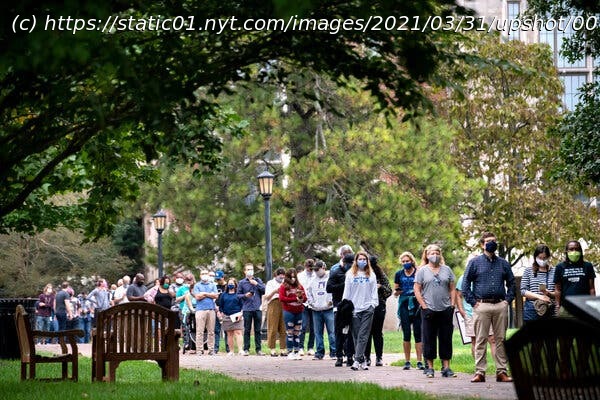Making voting convenient doesn’t necessarily translate into more votes, research shows.
There’s nothing unusual about exaggeration in politics. But when it comes to the debate over voting rights, something more than exaggeration is going on. There’s a real — and bipartisan — misunderstanding about whether making it easier or harder to vote, especially by mail, has a significant effect on turnout or electoral outcomes. The evidence suggests it does not. The fight over the new Georgia election law is only the latest example. That law, passed last week, has been condemned by Democrats as voter suppression, or even as tantamount to Jim Crow. Democrats are understandably concerned about a provision that empowers the Republican-controlled State Legislature to play a larger role in election administration. That provision has uncertain but potentially substantial effects, depending on what the Legislature might do in the future. And it’s possible the law is intended to do exactly what progressives fear: reshape the electorate to the advantage of Republicans, soon after an electoral defeat, by making it harder to vote. And yet the law’s voting provisions are unlikely to significantly affect turnout or Democratic chances. It could plausibly even increase turnout. In the final account, it will probably be hard to say whether it had any effect on turnout at all. The full text of the Georgia bill is here, but the bill’s major effects can be boiled down to a few points: If we leave aside the administrative provisions and the question of intent, the core question on voter suppression is to what extent does reducing voting options — like early voting in the runoffs or mail voting in general — reduce turnout and Democratic chances? For decades, reformers have assumed that the way to increase turnout is to make voting easier. Yet surprisingly, expanding voting options to make it more convenient hasn’t seemed to have a huge effect on turnout or electoral outcomes. That’s the finding of decades of political science research on advance, early and absentee voting. One prominent study even found that early voting decreases turnout, though that’s a bit of an outlier. There’s essentially no evidence that the vast expansion of no-excuse absentee mail voting, in which anyone can apply for a mail absentee ballot, had any discernible effect on turnout in 2020. That shouldn’t be a huge surprise: Even universal vote by mail, in which every registered voter is automatically sent a mail ballot (as opposed to every voter having an opportunity to apply for one), increases turnout by only about 2 percent with no discernible partisan advantage. Believe it or not, turnout increased just as much in the states that didn’t have no-excuse absentee voting as it did in the states that added it for the first time. Similarly, Joe Biden improved over Hillary Clinton’s performance by three percentage points in the states that added it, compared with 2.9 points in the states that did not. A more rigorous study by political scientists at Stanford found that no-excuse mail voting might have increased turnout by a whopping 0.02 percent in the 2020 election.






